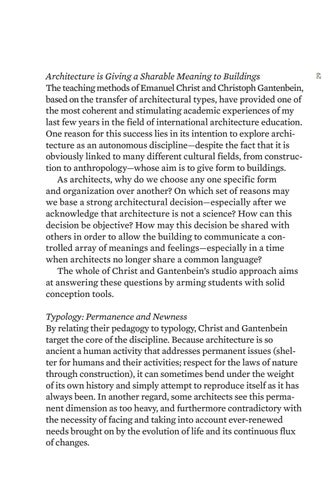Typology: Permanence and Newness By relating their pedagogy to typology, Christ and Gantenbein target the core of the discipline. Because architecture is so ancient a human activity that addresses permanent issues (shelter for humans and their activities; respect for the laws of nature through construction), it can sometimes bend under the weight of its own history and simply attempt to reproduce itself as it has always been. In another regard, some architects see this permanent dimension as too heavy, and furthermore contradictory with the necessity of facing and taking into account ever-renewed needs brought on by the evolution of life and its continuous flux of changes.
29
Architecture is Giving a Sharable Meaning to Buildings The teaching methods of Emanuel Christ and Christoph Gantenbein, based on the transfer of architectural types, have provided one of the most coherent and stimulating academic experiences of my last few years in the field of international architecture education. One reason for this success lies in its intention to explore architecture as an autonomous discipline—despite the fact that it is obviously linked to many different cultural fields, from construction to anthropology—whose aim is to give form to buildings. As architects, why do we choose any one specific form and organization over another? On which set of reasons may we base a strong architectural decision—especially after we acknowledge that architecture is not a science? How can this decision be objective? How may this decision be shared with others in order to allow the building to communicate a controlled array of meanings and feelings—especially in a time when architects no longer share a common language? The whole of Christ and Gantenbein’s studio approach aims at answering these questions by arming students with solid conception tools.
